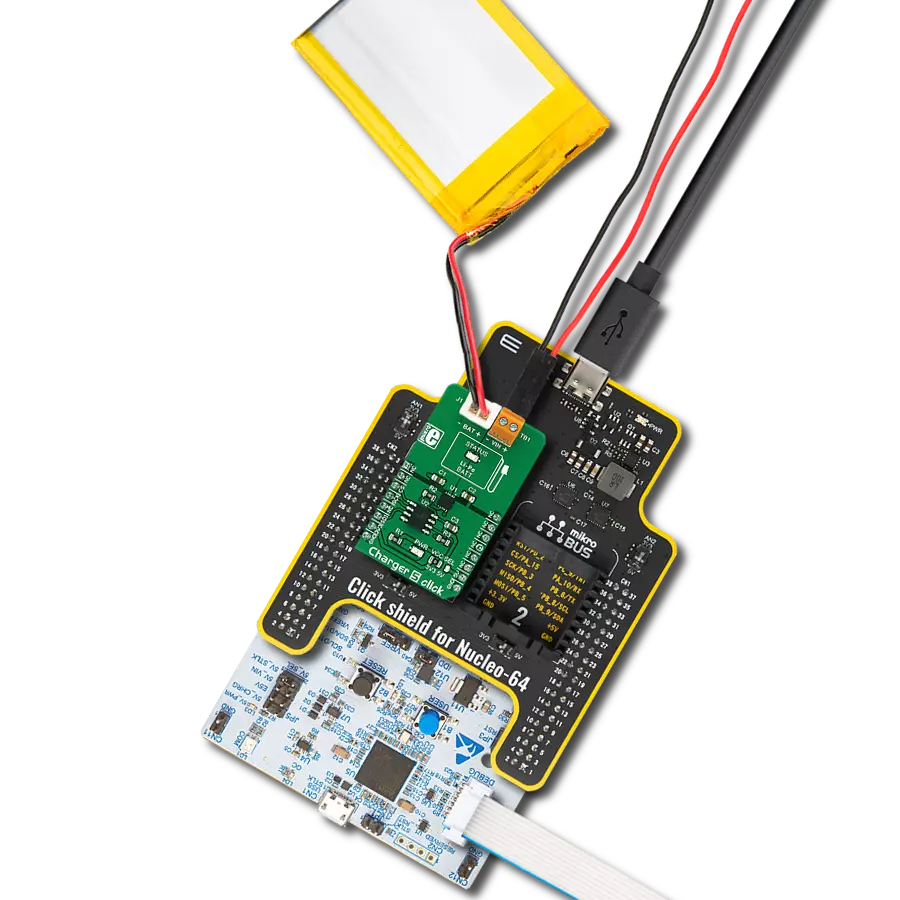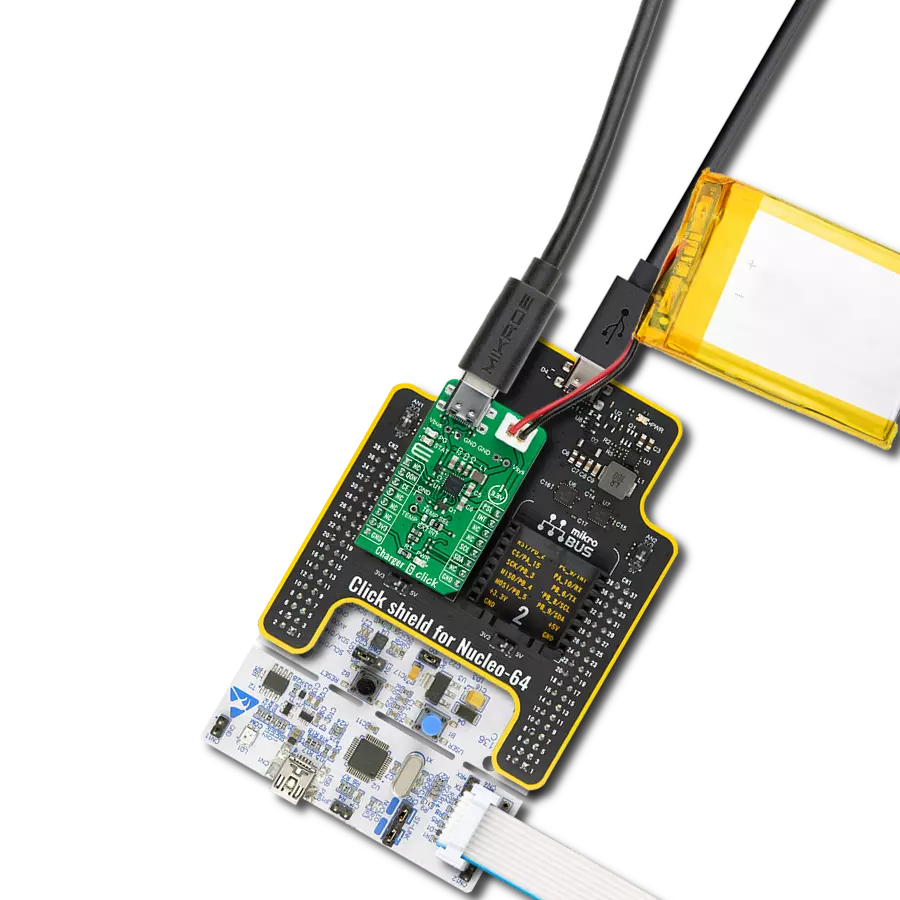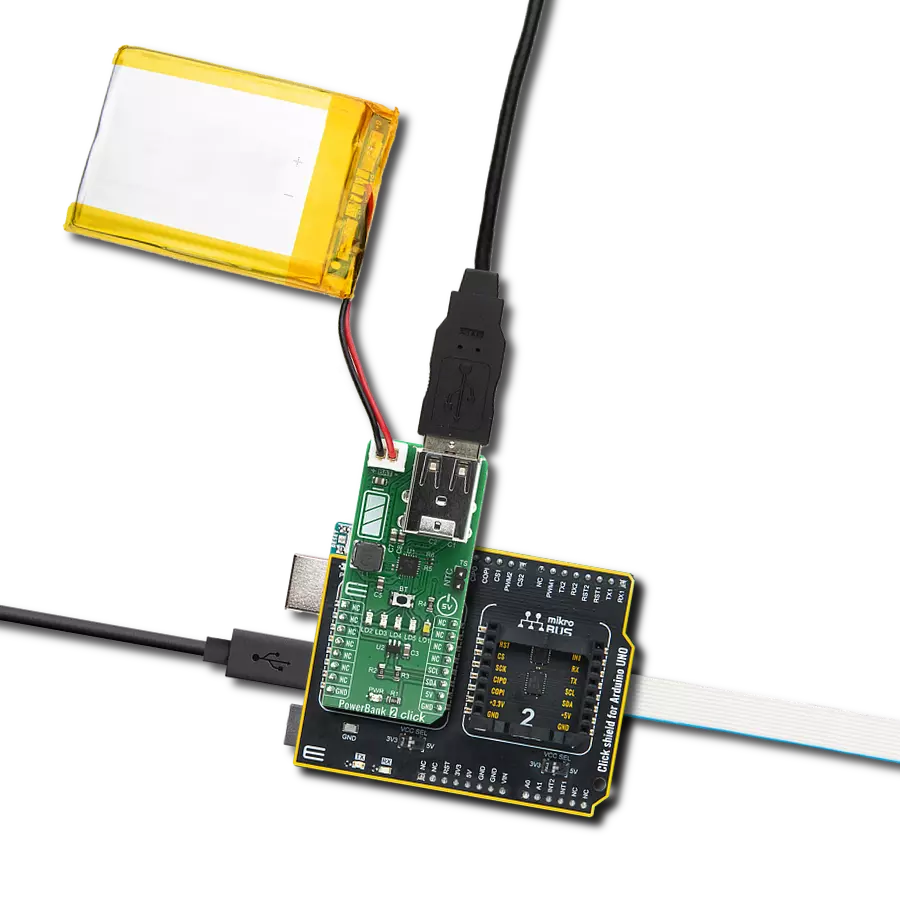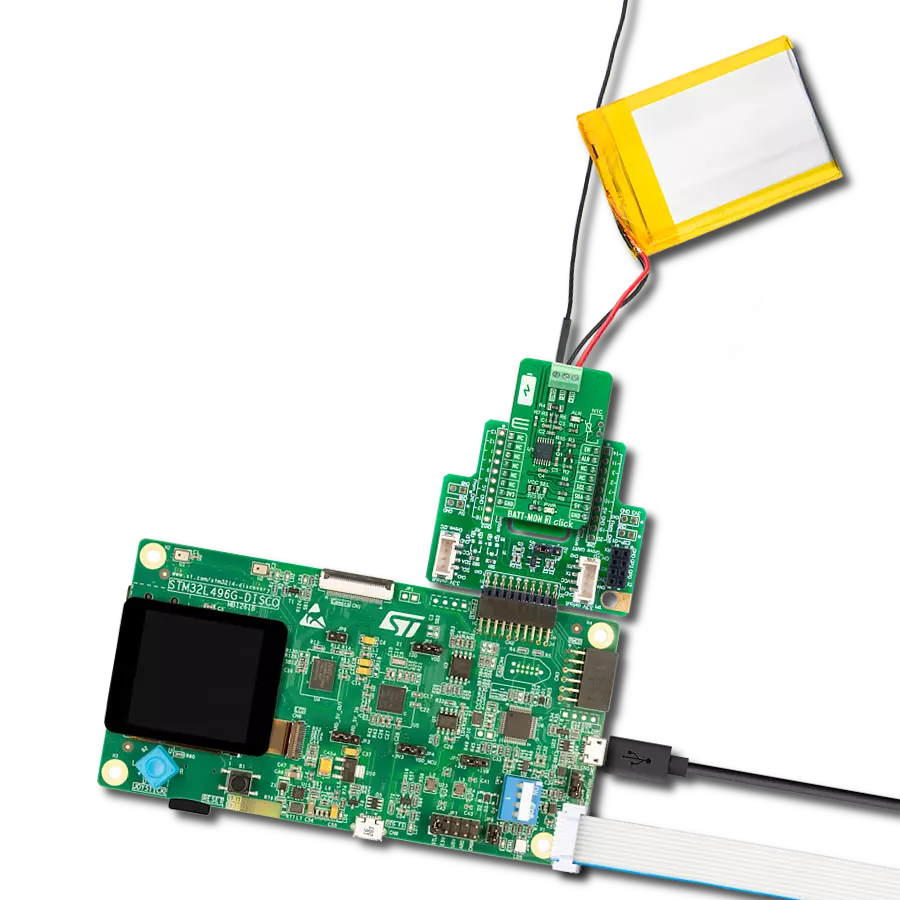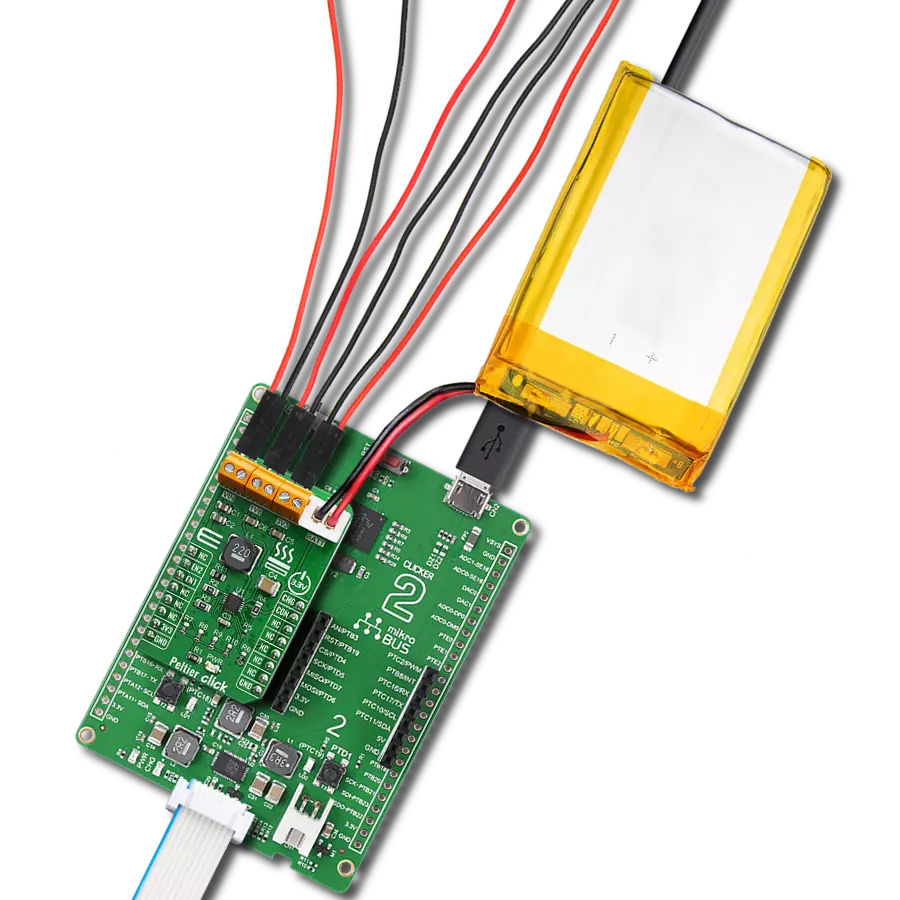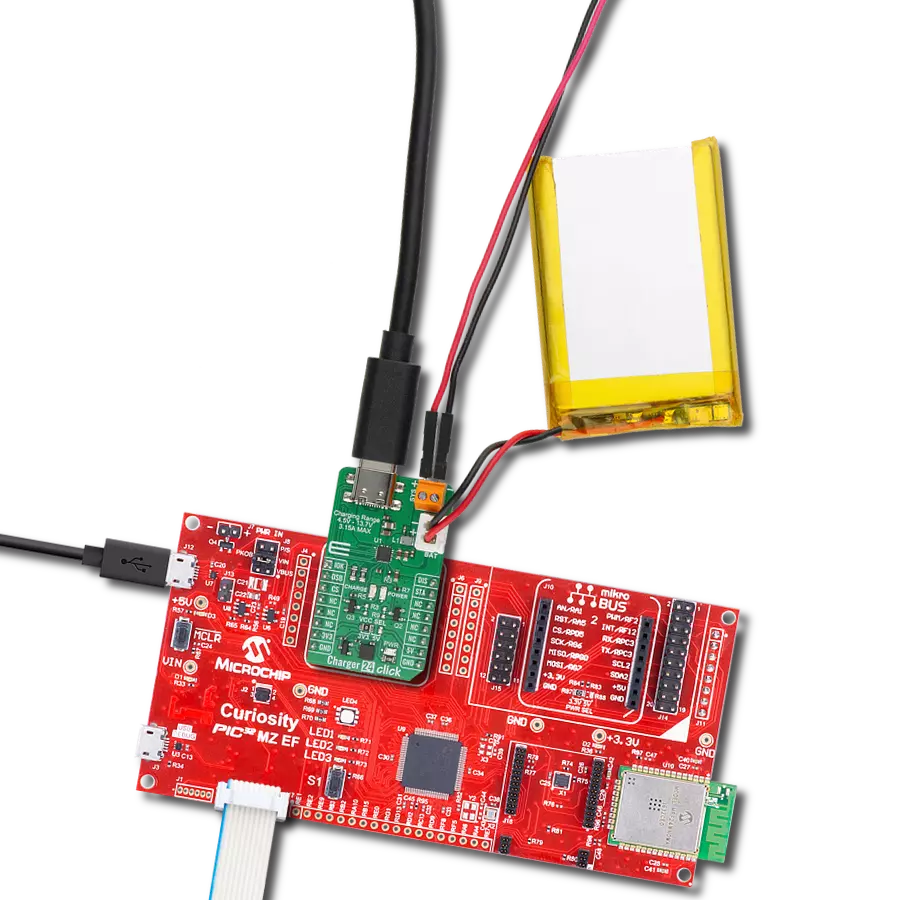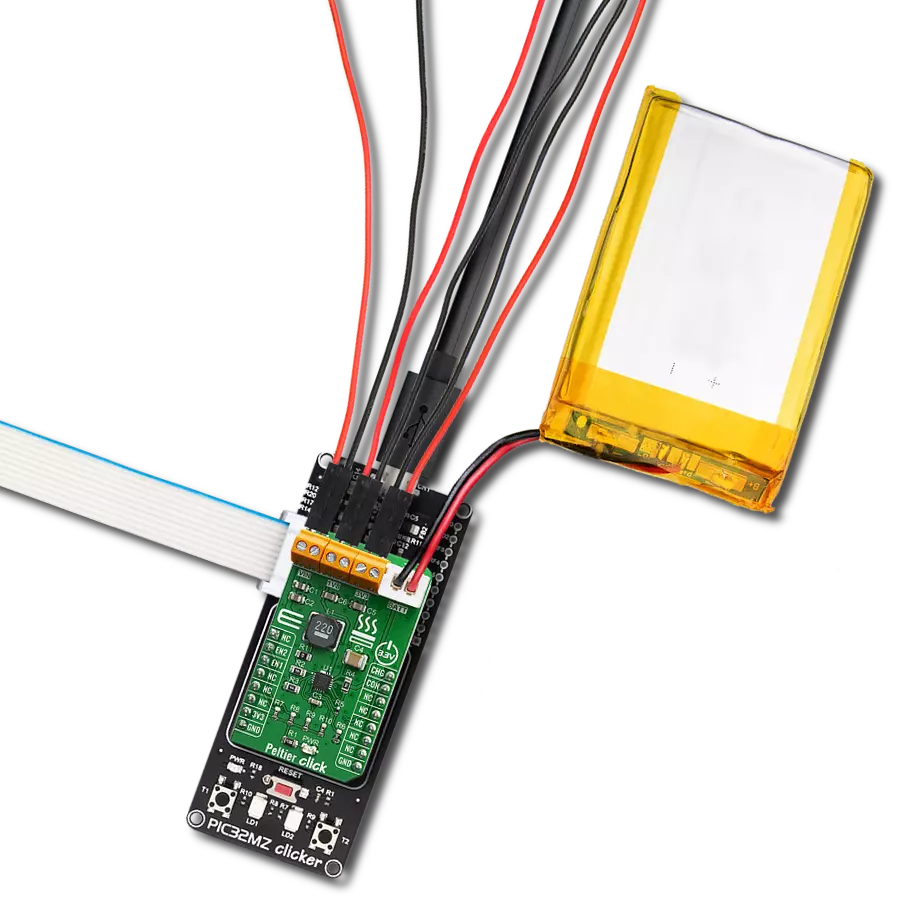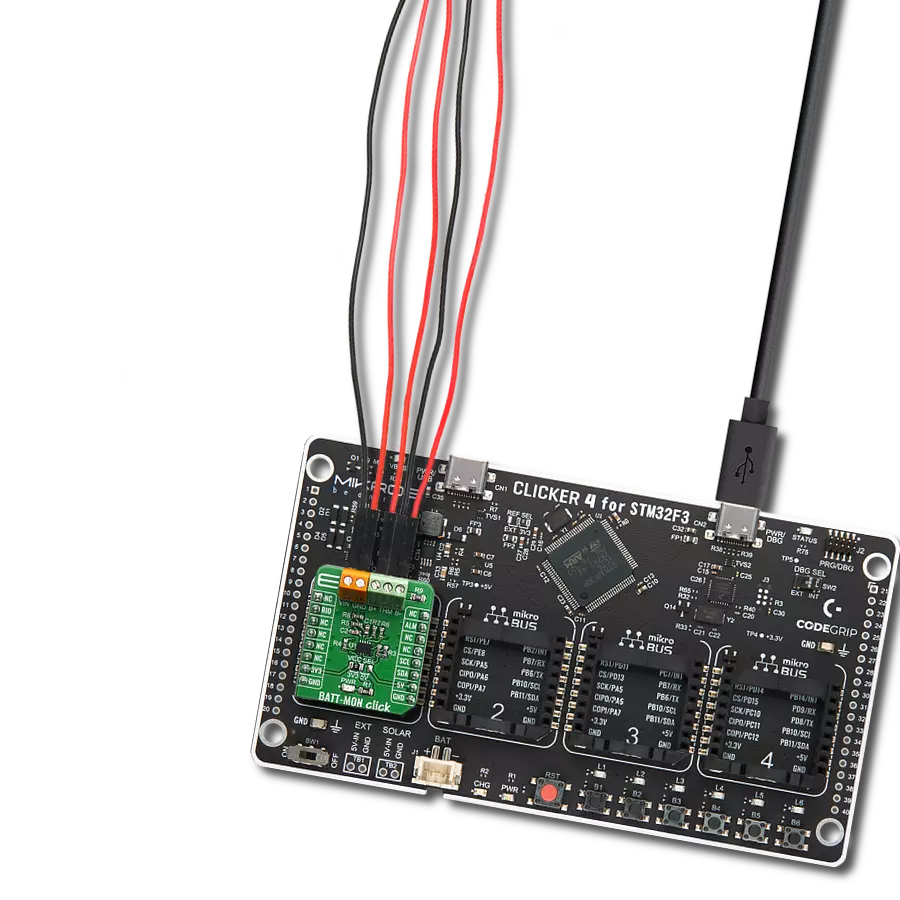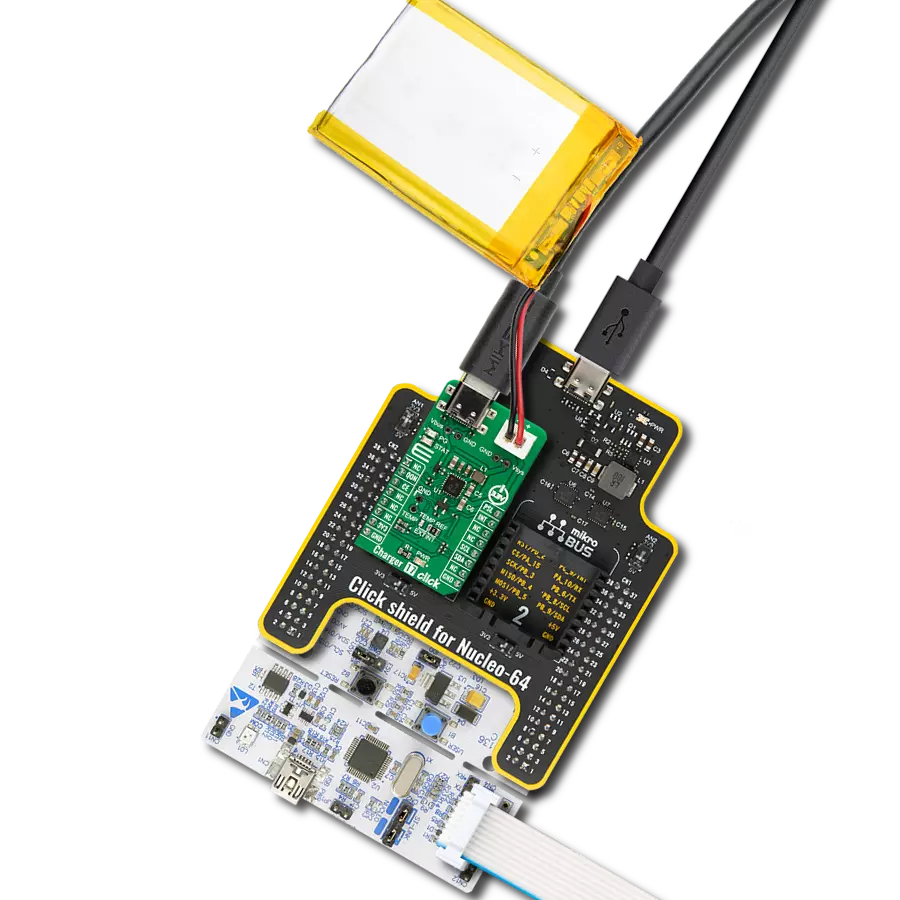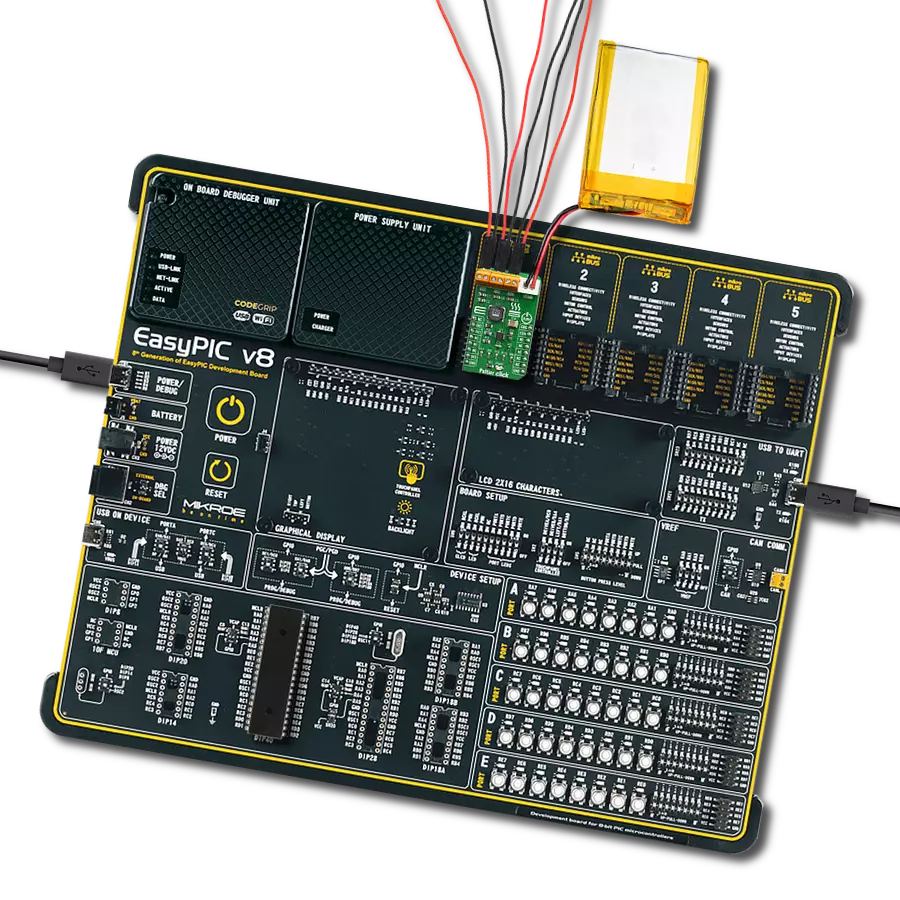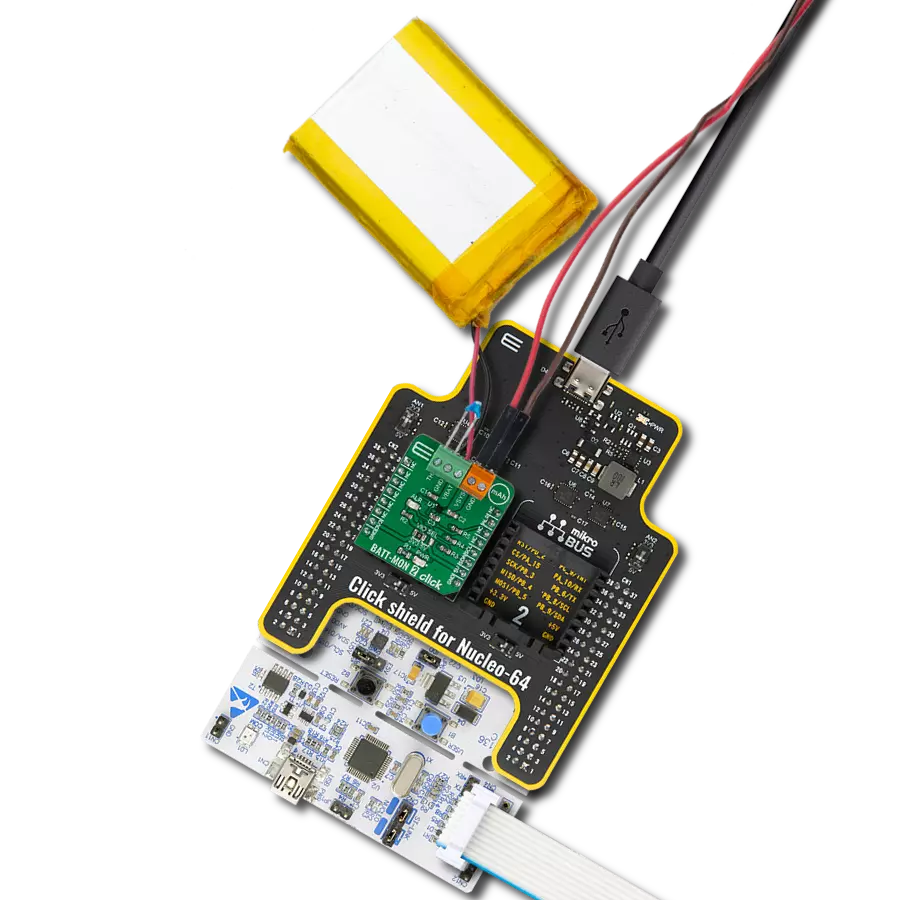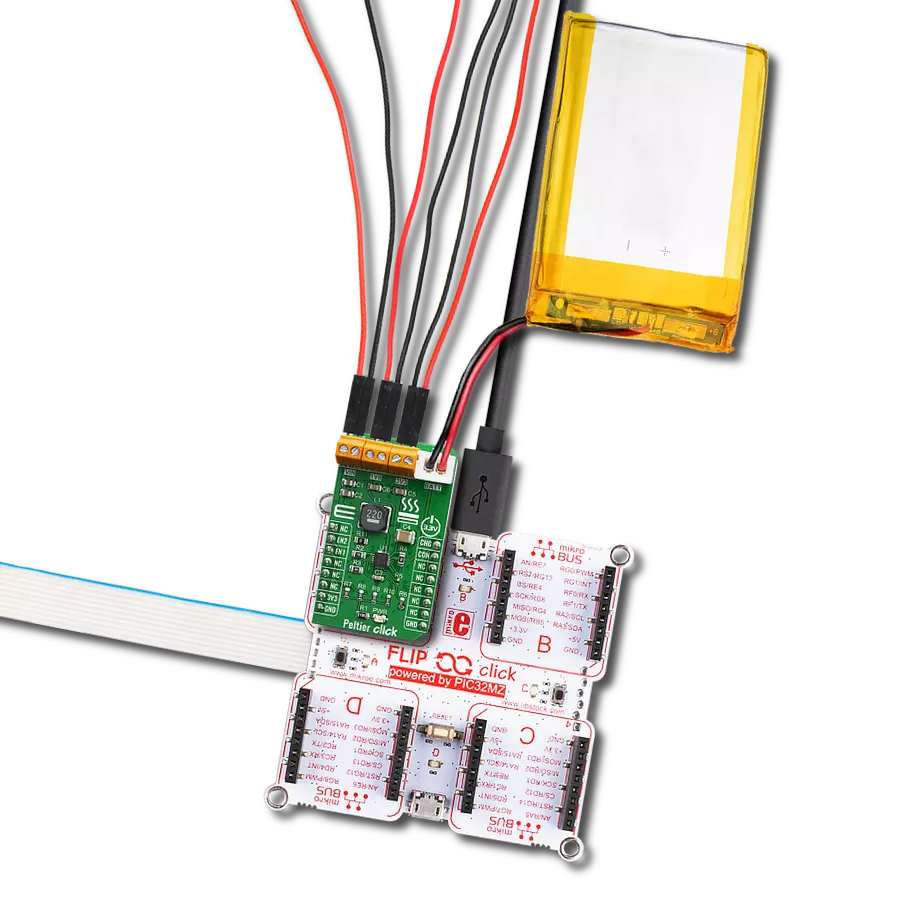Ensure the utmost safety and protection of your battery against voltage spikes and surges
A
A
Hardware Overview
How does it work?
Balancer 3 Click is based on the BQ29200, voltage protection with automatic cell balance for 2-series cell Li-Ion batteries from Texas Instruments. It includes all necessary components for the BQ29200 to ensure the proper functionality of the Click board™ and maintain the monitoring precision. Balancer 3 Click has two separate onboard battery connectors and an output voltage screw terminal to ensure the straightforward connecting of peripheries and, therefore, ease of use. The BQ29200 can operate in two different modes: internal cell balancing mode and external cell balancing mode. When internal cell balancing mode is used, the BQ29200 can handle up to 15 mA of balancing current. Although it is enough for many use cases, this Click board™
operates in external cell balancing mode, in which the external MOSFETs are used to regulate the balancing current. More precisely, one N-type MOSFET is wired between the positive and middle points of the batteries, and one P-type MOSFETs is wired between the middle point of the batteries and the ground. Resistor R3 is connected in series between the batteries and the middle point of the MOSFETS and therefore limits the maximum balancing current, which is by default about 350mA. The voltage of each cell in a 2-series cell battery pack is compared to an internal reference voltage. If either cell reaches an overvoltage condition, the BQ29200 device starts a timer that provides a delay proportional to the capacitance on the CD pin. Upon expiration of the internal
timer, the OUT pin changes from a low to a high state. Therefore, the OUT pin from the bq29200 is connected to the INT pin of the mikroBUS™ socket, enabling the user to write the desired interrupt routine in case of battery overvoltage, as well as turn off the device, using the CS pin of the mikroBUS™. This Click board™ can only be operated with a 3.3V logic voltage level. The board must perform appropriate logic voltage level conversion before using MCUs with different logic levels. However, the Click board™ comes equipped with a library containing functions and an example code that can be used as a reference for further development.
Features overview
Development board
Clicker 2 for Kinetis is a compact starter development board that brings the flexibility of add-on Click boards™ to your favorite microcontroller, making it a perfect starter kit for implementing your ideas. It comes with an onboard 32-bit ARM Cortex-M4F microcontroller, the MK64FN1M0VDC12 from NXP Semiconductors, two mikroBUS™ sockets for Click board™ connectivity, a USB connector, LED indicators, buttons, a JTAG programmer connector, and two 26-pin headers for interfacing with external electronics. Its compact design with clear and easily recognizable silkscreen markings allows you to build gadgets with unique functionalities and
features quickly. Each part of the Clicker 2 for Kinetis development kit contains the components necessary for the most efficient operation of the same board. In addition to the possibility of choosing the Clicker 2 for Kinetis programming method, using a USB HID mikroBootloader or an external mikroProg connector for Kinetis programmer, the Clicker 2 board also includes a clean and regulated power supply module for the development kit. It provides two ways of board-powering; through the USB Micro-B cable, where onboard voltage regulators provide the appropriate voltage levels to each component on the board, or
using a Li-Polymer battery via an onboard battery connector. All communication methods that mikroBUS™ itself supports are on this board, including the well-established mikroBUS™ socket, reset button, and several user-configurable buttons and LED indicators. Clicker 2 for Kinetis is an integral part of the Mikroe ecosystem, allowing you to create a new application in minutes. Natively supported by Mikroe software tools, it covers many aspects of prototyping thanks to a considerable number of different Click boards™ (over a thousand boards), the number of which is growing every day.
Microcontroller Overview
MCU Card / MCU
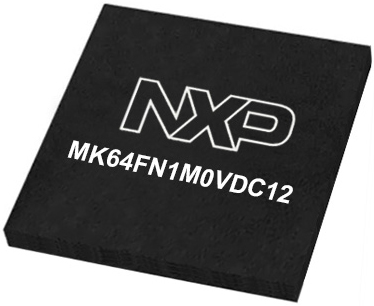
Architecture
ARM Cortex-M4
MCU Memory (KB)
1024
Silicon Vendor
NXP
Pin count
121
RAM (Bytes)
262144
You complete me!
Accessories
Li-Polymer Battery is the ideal solution for devices that demand a dependable and long-lasting power supply while emphasizing mobility. Its compatibility with mikromedia boards ensures easy integration without additional modifications. With a voltage output of 3.7V, the battery meets the standard requirements of many electronic devices. Additionally, boasting a capacity of 2000mAh, it can store a substantial amount of energy, providing sustained power for extended periods. This feature minimizes the need for frequent recharging or replacement. Overall, the Li-Polymer Battery is a reliable and autonomous power source, ideally suited for devices requiring a stable and enduring energy solution. You can find a more extensive choice of Li-Polymer batteries in our offer.
Used MCU Pins
mikroBUS™ mapper
Take a closer look
Click board™ Schematic

Step by step
Project assembly
Track your results in real time
Application Output
1. Application Output - In Debug mode, the 'Application Output' window enables real-time data monitoring, offering direct insight into execution results. Ensure proper data display by configuring the environment correctly using the provided tutorial.

2. UART Terminal - Use the UART Terminal to monitor data transmission via a USB to UART converter, allowing direct communication between the Click board™ and your development system. Configure the baud rate and other serial settings according to your project's requirements to ensure proper functionality. For step-by-step setup instructions, refer to the provided tutorial.

3. Plot Output - The Plot feature offers a powerful way to visualize real-time sensor data, enabling trend analysis, debugging, and comparison of multiple data points. To set it up correctly, follow the provided tutorial, which includes a step-by-step example of using the Plot feature to display Click board™ readings. To use the Plot feature in your code, use the function: plot(*insert_graph_name*, variable_name);. This is a general format, and it is up to the user to replace 'insert_graph_name' with the actual graph name and 'variable_name' with the parameter to be displayed.

Software Support
Library Description
This library contains API for Balancer 3 Click driver.
Key functions:
balancer3_enable_cell_balance- Cell Balance Enable functionbalancer3_check_overvoltage_cond- Overvoltage Condition Check function
Open Source
Code example
The complete application code and a ready-to-use project are available through the NECTO Studio Package Manager for direct installation in the NECTO Studio. The application code can also be found on the MIKROE GitHub account.
/*!
* \file
* \brief Balancer 3 Click example
*
* # Description
* This application is device for 2-series cell lithium-ion battery.
*
* The demo application is composed of two sections :
*
* ## Application Init
* Initializes device coummunication and enables cell balancing.
*
* ## Application Task
* Checks if overvoltage is occured and disables cell balancing.
* If overvoltage doesn't occur it enables cell balancing.
*
* \author MikroE Team
*
*/
// ------------------------------------------------------------------- INCLUDES
#include "board.h"
#include "log.h"
#include "balancer3.h"
// ------------------------------------------------------------------ VARIABLES
static balancer3_t balancer3;
static log_t logger;
// ------------------------------------------------------ APPLICATION FUNCTIONS
void application_init ( void )
{
log_cfg_t log_cfg;
balancer3_cfg_t cfg;
/**
* Logger initialization.
* Default baud rate: 115200
* Default log level: LOG_LEVEL_DEBUG
* @note If USB_UART_RX and USB_UART_TX
* are defined as HAL_PIN_NC, you will
* need to define them manually for log to work.
* See @b LOG_MAP_USB_UART macro definition for detailed explanation.
*/
LOG_MAP_USB_UART( log_cfg );
log_init( &logger, &log_cfg );
log_info( &logger, " Application Init " );
// Click initialization.
balancer3_cfg_setup( &cfg );
BALANCER3_MAP_MIKROBUS( cfg, MIKROBUS_1 );
balancer3_init( &balancer3, &cfg );
balancer3_enable_cell_balance( &balancer3, BALANCER3_CELL_BALANCE_EN );
log_printf( &logger, "* Normal operation - Cell balance enabled *\r\n" );
log_info( &logger, " Application Task " );
}
void application_task ( void )
{
static uint8_t old_ov_state = 0;
uint8_t ov_state = balancer3_check_overvoltage( &balancer3 );
if ( old_ov_state != ov_state )
{
old_ov_state = ov_state;
if ( BALANCER3_OV_COND_NOT_DETECTED == ov_state )
{
log_printf( &logger, "* Normal operation - Cell balance enabled *\r\n" );
balancer3_enable_cell_balance( &balancer3, BALANCER3_CELL_BALANCE_EN );
}
else
{
log_printf( &logger, "* Overvoltage condition - Cell balance disabled * \r\n" );
balancer3_enable_cell_balance( &balancer3, BALANCER3_CELL_BALANCE_DIS );
}
}
Delay_ms ( 1 );
}
int main ( void )
{
/* Do not remove this line or clock might not be set correctly. */
#ifdef PREINIT_SUPPORTED
preinit();
#endif
application_init( );
for ( ; ; )
{
application_task( );
}
return 0;
}
// ------------------------------------------------------------------------ END



















